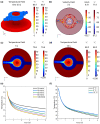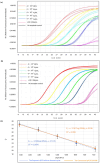A Thermal Cycler Based on Magnetic Induction Heating and Anti-Freezing Water Cooling for Rapid PCR
- PMID: 39770215
- PMCID: PMC11679298
- DOI: 10.3390/mi15121462
A Thermal Cycler Based on Magnetic Induction Heating and Anti-Freezing Water Cooling for Rapid PCR
Abstract
Distinguished by its exceptional sensitivity and specificity, Polymerase Chain Reaction (PCR) is a pivotal technology for pathogen detection. However, traditional PCR instruments that employ thermoelectric cooling (TEC) are often constrained by cost, efficiency, and performance variability resulting from the fluctuations in ambient temperature. Here, we present a thermal cycler that utilizes electromagnetic induction heating at 50 kHz and anti-freezing water cooling with a velocity of 0.06 m/s to facilitate rapid heating and cooling of the PCR reaction chamber, significantly enhancing heat transfer efficiency. A multi-physics theoretical heat transfer model, developed using the digital twin approach, enables precise temperature control through advanced algorithms. Experimental results reveal average heating and cooling rates of 14.92 °C/s and 13.39 °C/s, respectively, significantly exceeding those of conventional methods. Compared to commercial PCR instruments, the proposed system further optimizes cost, efficiency, and practicality. Finally, PCR experiments were successfully performed using cDNA (Hepatitis B virus) at various concentrations.
Keywords: anti-freezing water cooling; magnetic induction heating; polymerase chain reaction; rapid heat transfer; thermal cycler.
Conflict of interest statement
Author Yaping Xie was employed by the Sansure Biotech Inc. The remaining authors declare that the research was conducted in the absence of any commercial or financial relationships that could be construed as a potential conflict of interest.
Figures






Similar articles
-
Battery Powered Portable Thermal Cycler for Continuous-Flow Polymerase Chain Reaction Diagnosis by Single Thermostatic Thermoelectric Cooler and Open-Loop Controller.Sensors (Basel). 2019 Apr 3;19(7):1609. doi: 10.3390/s19071609. Sensors (Basel). 2019. PMID: 30987195 Free PMC article.
-
Smartphone-operated affordable PCR thermal cycler for the detection of antimicrobial resistant bacterial genes.PLOS Glob Public Health. 2023 Feb 27;3(2):e0001120. doi: 10.1371/journal.pgph.0001120. eCollection 2023. PLOS Glob Public Health. 2023. PMID: 36962978 Free PMC article.
-
Portable low-power thermal cycler with dual thin-film Pt heaters for a polymeric PCR chip.Biomed Microdevices. 2018 Jan 29;20(1):14. doi: 10.1007/s10544-018-0257-9. Biomed Microdevices. 2018. PMID: 29376193
-
Investigations of Li-Ion Battery Thermal Management Systems Based on Heat Pipes: A Review.ACS Omega. 2023 Dec 26;9(1):97-116. doi: 10.1021/acsomega.3c08056. eCollection 2024 Jan 9. ACS Omega. 2023. PMID: 38222571 Free PMC article. Review.
-
Elevating Low-Grade Heat Harvesting with Daytime Radiative Cooling and Solar Heating in Thermally Regenerative Electrochemical Cycles.ACS Appl Mater Interfaces. 2024 Dec 11;16(49):66932-66938. doi: 10.1021/acsami.3c19498. Epub 2024 Apr 22. ACS Appl Mater Interfaces. 2024. PMID: 38644801 Review.
Cited by
-
Seeking Solutions for Inclusively Economic, Rapid, and Safe Molecular Detection of Respiratory Infectious Diseases: Comprehensive Review from Polymerase Chain Reaction Techniques to Amplification-Free Biosensing.Micromachines (Basel). 2025 Apr 15;16(4):472. doi: 10.3390/mi16040472. Micromachines (Basel). 2025. PMID: 40283347 Free PMC article. Review.
-
An open source, PCR based, point-of-care testing platform.Sci Rep. 2025 Apr 8;15(1):12025. doi: 10.1038/s41598-025-95639-x. Sci Rep. 2025. PMID: 40199931 Free PMC article.
References
Grants and funding
LinkOut - more resources
Full Text Sources

